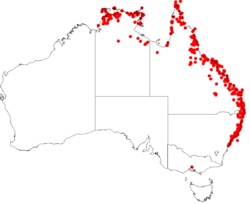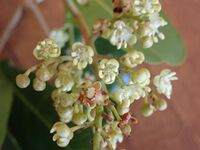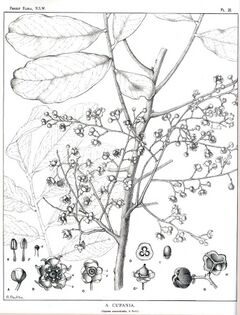Biology:Cupaniopsis anacardioides
| Tuckeroo | |
|---|---|

| |
| Cupaniopsis anacardioides | |
| Scientific classification | |
| Kingdom: | Plantae |
| Clade: | Tracheophytes |
| Clade: | Angiosperms |
| Clade: | Eudicots |
| Clade: | Rosids |
| Order: | Sapindales |
| Family: | Sapindaceae |
| Genus: | Cupaniopsis |
| Species: | C. anacardioides
|
| Binomial name | |
| Cupaniopsis anacardioides | |

| |
| Occurrence data from AVH | |
| Synonyms | |
|
Cupania anacardioides A.Rich. | |
Cupaniopsis anacardioides, with common names tuckeroo, carrotwood, beach tamarind and green-leaved tamarind, is a species of flowering tree in the soapberry family, Sapindaceae, that is native to eastern and northern Australia . The usual habitat is littoral rainforest on sand or near estuaries.[3] The range of natural distribution is from Seven Mile Beach, New South Wales (34.8° S) to Queensland, northern Australia and New Guinea.[4][5]
Cupaniopsis anacardioides is an invasive species in some parts of the United States, primarily Florida and Hawaii.[6][7]
Description
Growing up to 10 metres (33 ft) with a stem diameter of 50 centimetres (20 in). The bark is smooth grey or brown with raised horizontal lines. The bases of the trees are usually flanged.[4][5]
Leaves are pinnate and alternate with six to ten leaflets. These are not toothed, and are egg-shaped to elliptic-oblong, and 7 to 10 centimetres (2.8 to 3.9 in) long. The tips are often notched or blunt. Leaf veins are evident on both sides. The veins are mostly raised underneath.[4][5]
Greenish white flowers form on panicles from May to July. The fruit is an orange to yellow capsule with three lobes. There is a glossy dark brown seed inside each lobe. The seeds are covered in a bright orange aril. Fruit ripens from October to December, attracting many birds including Australasian figbird, olive-backed oriole and pied currawong.[4][5]
Germination from fresh seed occurs without difficulty, particularly if the seed is removed from the aril and soaked for a few days.[4][5]


Uses
It is an attractive plant as an ornamental or a street tree, particularly in coastal areas as it is salt tolerant.[8]

References
- ↑ "APNI Cupaniopsis anacardioides". Australian Plant Name Index. https://biodiversity.org.au/nsl/services/rest/name/apni/90234/api/apni-format.
- ↑ Radlkofer, L.A.T. (1879) Ueber Cupania und damit verwandte pflanzen. Sitzungsberichte der Mathematisch-Physikalischen Classe der Königlichen Bayerischen Akademie der Wissenschaften zu Munchen 4: 512, 530, 585
- ↑ "PCA Alien Plant Working Group - Carrotwood (Cupaniopsis anacardioides)". https://www.invasive.org/alien/fact/cuan1.htm.
- ↑ 4.0 4.1 4.2 4.3 4.4 Harden, Gwen J. (1991). "Cupaniopsis anacardioides". PlantNET - NSW Flora Online. http://plantnet.rbgsyd.nsw.gov.au/cgi-bin/NSWfl.pl?page=nswfl&lvl=sp&name=Cupaniopsis~anacardioides.
- ↑ 5.0 5.1 5.2 5.3 5.4 Floyd, A. G. (2008). Rainforest Trees of Mainland South-eastern Australia (2nd, Revised ed.). Lismore, New South Wales: Terania Rainforest Publishing. p. 385. ISBN 978-0-958943-67-3. http://rainforestpublishing.com.au/shop/rainforest-trees-of-south-eastern-australia/. Retrieved 2009-06-18.
- ↑ "Cupaniopsis anacardioides as a weed in Florida". University of Florida. http://edis.ifas.ufl.edu/AG111.
- ↑ "Sapindaceae Fruits and Seeds". USDA Agricultural Research Service. https://nt.ars-grin.gov/SeedsFruits/rptSeedsFruitsFamData.cfm?thisFamily=Sapindaceae.
- ↑ Langeland, K.A.; Enloe, S.F. (2015). "EDIS SS-AGR-165: Natural Area Weeds Carrotwood (Cupaniopsis anacardioides)". University of Florida. http://edis.ifas.ufl.edu/ag111#FIGURE%203.
External links
- "Cupaniopsis anacardioides". PlantNET - NSW Flora Online. http://plantnet.rbgsyd.nsw.gov.au/cgi-bin/NSWfl.pl?page=nswfl&lvl=sp&name=Cupaniopsis~anacardioides.
Wikidata ☰ Q3005741 entry
 |

